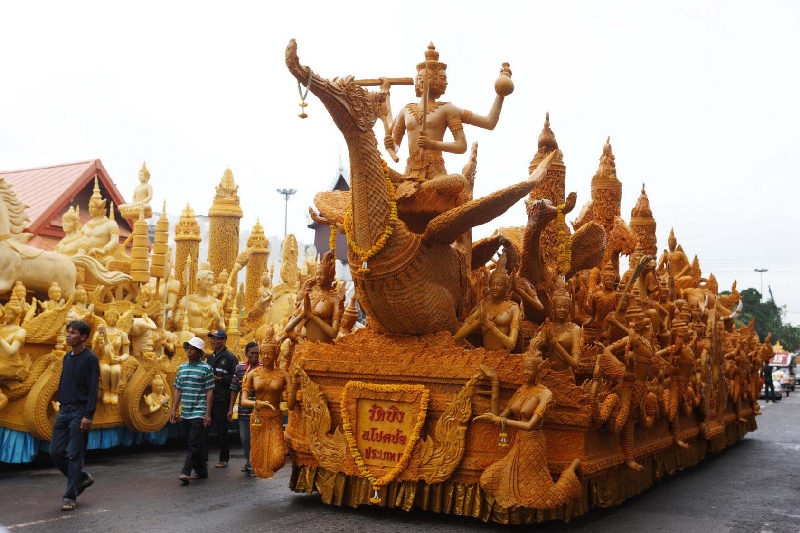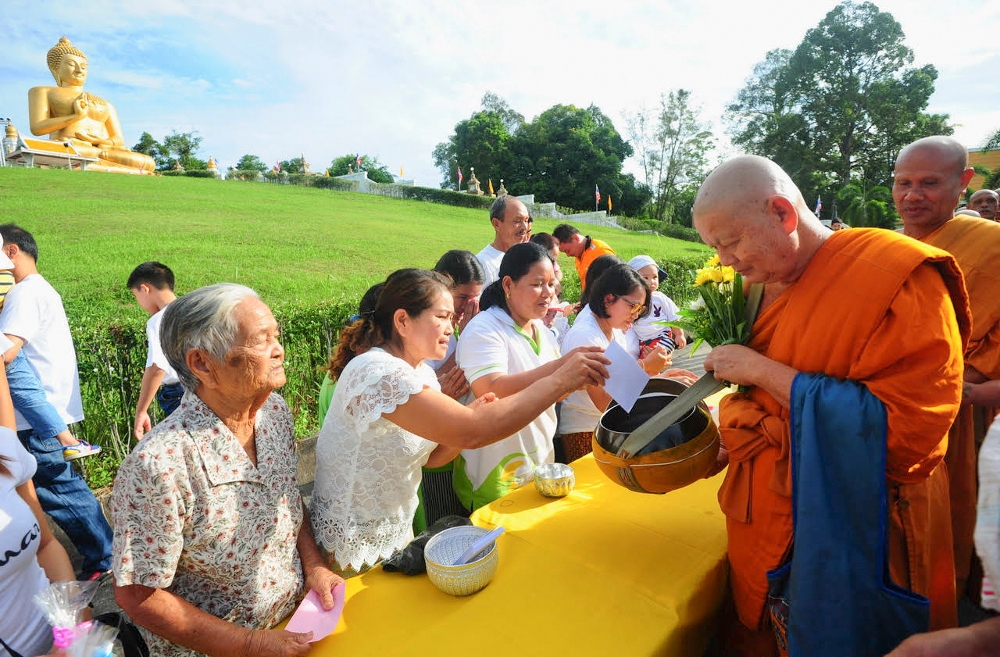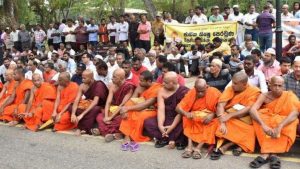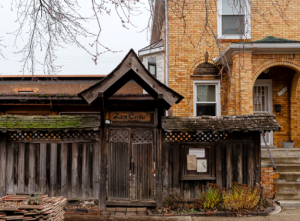
Thailand’s Khao Phansa festival marks the beginning of the annual, three-month rains retreat for monastics (Pali: vassavasa), beginning the day after the full moon of the eighth lunar month. The specific dates of the rains retreat therefore vary, depending on when the full moon begins in June-July and when it ends in September-October of the Theravada Buddhist lunar calendar. This year, Khao Phansa began on 20 July and will end on 16 October.
Vassavasa originated in India as a period during which the ancient monastic order ceased their itinerant activities for three months during the monsoon season. The Buddha advised his disciples to observe the rains retreat for two main reasons. Firstly, the monsoons during this time made travel by foot in India somewhat dangerous—paths were muddy, roads were covered with water, and rivers overflowed. Secondly, there was a greater potential of inadvertantly causing harm to animals—when monks walked during the rainy season, they found themselves accidentally stepping on or injuring all kinds of wildlife, including creatures that came up to the earth’s surface during and immediately after the rains. While all monks and nuns were expected to observe the rains retreat, the Buddha granted a leave period of up to seven days under certain circumstances, such as attending to matters of the sangha, giving a Dhamma teaching, or visiting a sick relative.
At some unspecified point in history, the term “Buddhist Lent” was carelessly attached to vassavasa by observers who noticed that some lay Buddhists in Southeast Asia fasted during the rains retreat, invoking parallels with the Christian Lent (despite vassavasa predating Lent by more than five centuries). In Bangladesh, Myanmar, Sri Lanka, and Thailand, many devoted lay Buddhists do indeed observe vassavasa by adopting more ascetic practices such as giving up meat, alcohol, and tobacco. They also engage in meritorious activities, including offering alms to the sangha, observing the Eight Precepts, practicing meditation, and listening to Dhamma talks.
In Thailand, Khao Phansa heralds a time for renewed spiritual activity. Meritorious acts associated with Khao Phansa involve donations of carved wax candles to temples, which the monks use as visual aids while chanting Buddhist texts through the night and performing other functions. Candle processions also take place throughout the country. Some of the most famous provincial processions are the International Wax Candle Festival and Wax Candle Procession in Ubon Ratchathani, the Candle Festivals in Nakhon Phanom and Suphanburi, the Korat Candle Procession Festival in Nakhon Ratchasima, and Saraburi’s Tak Bat Dok Mai (Floral Merit-making) and Royal Candle Festival.
On 20 July this year, Ubon Ratchathani hosted the remarkable 10th International Wax Carving Competition, which was joined by artists from around the world. The province showcased the Candle Festival at Thung Si Mueang, where visitors marveled at a spectacular parade of ornately carved wax sculptures and candles. The procession was accompanied by religious rituals, light and sound presentations during the evening, folk dance performances, a tour of candle-making communities, and sales of local products. Each province also has its own unique activites: for example, in Nakhon Phanom, religious activities were performed at the important temple of Wat Phra That Phanom, while Surin Province organized nearly 100 elaborately dressed elephants carrying respected monks through the provincial capital. The riverside market of Lat Chado in Ayutthaya Province is also famous for the Aquatic Phansa Festival, during which wax sculptures and candles are paraded on boats decorated with flowers.

According to the Pattaya Mail newspaper, Khao Phansa has three classes of ceremonies: the royal ceremony conducted by the king of Thailand, ritual ceremonies for lay followers of Buddhism throughout the country, and ceremonies performed by monks and nuns in the temples. The royal ceremony is conducted by the king and members of the royal family, who perform rituals that include paying homage to the Buddha, presenting candles for Khao Phansa, and offering garments to monastics.
Lay Buddhists all over Thailand and in other Theravada countries observe the day by performing various meritorious acts. In the morning, laypeople gather in the temple to undertake the Five or Eight Precepts for the day. There is a long period of chanting, paying homage to the Buddha, the Dhamma, and the sangha, accompanied by offerings of food, flowers, incense, lamps, and other items. Monks and nuns observing the rains retreat perform these ceremonies. According to my personal experience as a monk as well as the New Light of Myanmar newspaper, every monastic will have taken a vow on the retreat’s first day by reciting the following stanza: “imasmiṃ vihare imaṃ temasaṃ vassaṃ upemi,” which means, “I will stay in this monastery during the three months of rainy season.” (New Light of Myanmar). It is also common for men to take temporary ordination as monks for the duration of the rains retreat.
Khao Phansa is preceded by another important Buddhist celebration called Asanha Bucha in Thai, or Asalha Puja in Pali. This festival commemorates the historical Buddha’s first teaching as recorded in the Dhammacakkappavattana Sutta (The Discourse of Setting in Motion of the Wheel of the Dharma) at Sarnath, India, after attaining enlightenment. The Buddha gave his first discourse on The Middle Way to five ascetics, former companions during his search for wisdom, who became his first disciples. Asanha Bucha and Khao Phansa are the most significant religious ceremonies in Thailand (Asanha Bucha was celebrated this year on 19 July). Both are national holidays, during which it is against the law to sell alcoholic beverages. Bars and entertainment places are therefore closed.

The “Buddhist Lent” of Thailand is an auspicious event of monumental historic significance. It comes with opportunities to make merit, benefiting not only the members of the monastic sangha but also lay Buddhists, who are afforded the opportunity to treat one another especially well in the spirit of the sacred festival, enhancing harmony within the community. “Buddhist Lent is not only a time to refrain from inappropriate acts, such as drinking, gambling or overindulgence, but also a time to dedicate one’s efforts to meditating, giving alms, adhering to Buddhist virtues, and listening to Buddhist sermons,” said Thai prime minister Gen. Prayut Chan-o-Cha, in a statement. (Latin American Herald Tribune)
The end of the rains retreat is marked by the Pavarana ceremony, during which sangha members have the opportunity to admonish one another for any misdeeds committed during the retreat. It is followed by the Kathina or robe-offering festival, which continues for one month.
See more
Buddhist Lent begins this week (Pattaya Mail)
2016 Buddhist Lent Celebrations (TAT News)
The Ordination Festival of the month “Waso” (New Light of Myanmar)
Ubon Ratchathani Candle Festival: 1-20 July 2016 (Thailand Festivals 2016)
Thai Govt urges people to refrain from drinking alcohol during Buddhist Lent (Thai Visa News)
Candles, Dance and Sobriety Mark Start of Buddhist Lent in Thailand (Latin American Herald Tribune)
Buddhist Rains-retreat (vassāvāsa) – a courtesy of monasticism (Buddhistdoor Global)
Pavarana: Marking the End of the Rains Retreat (Buddhistdoor Global)











